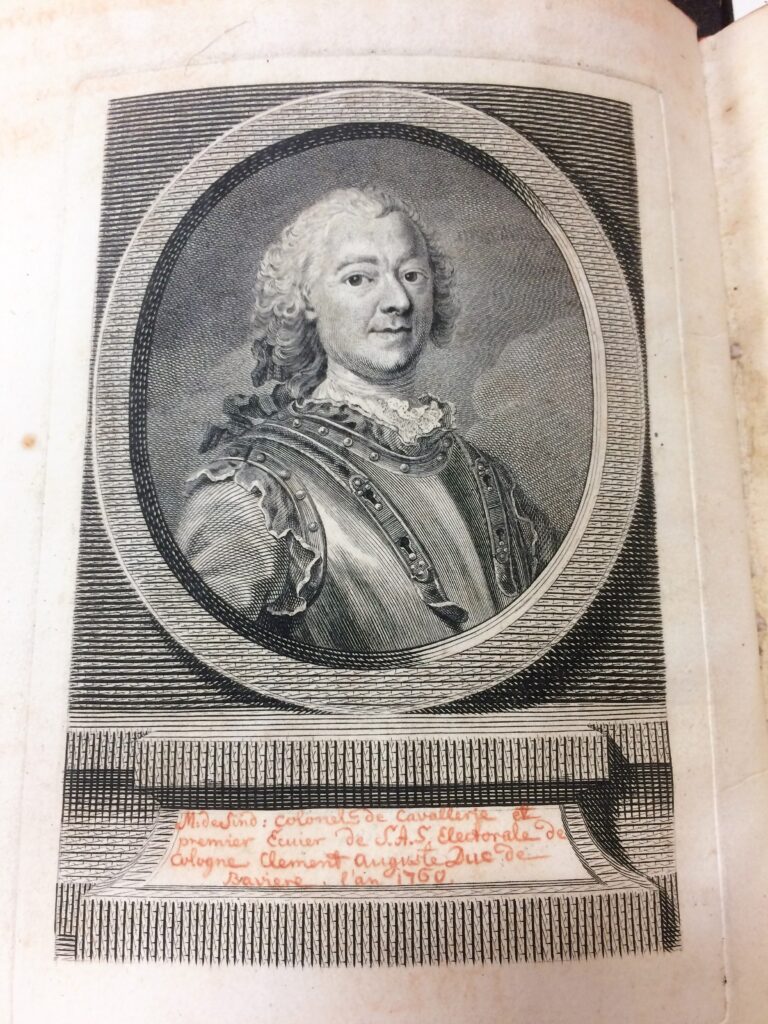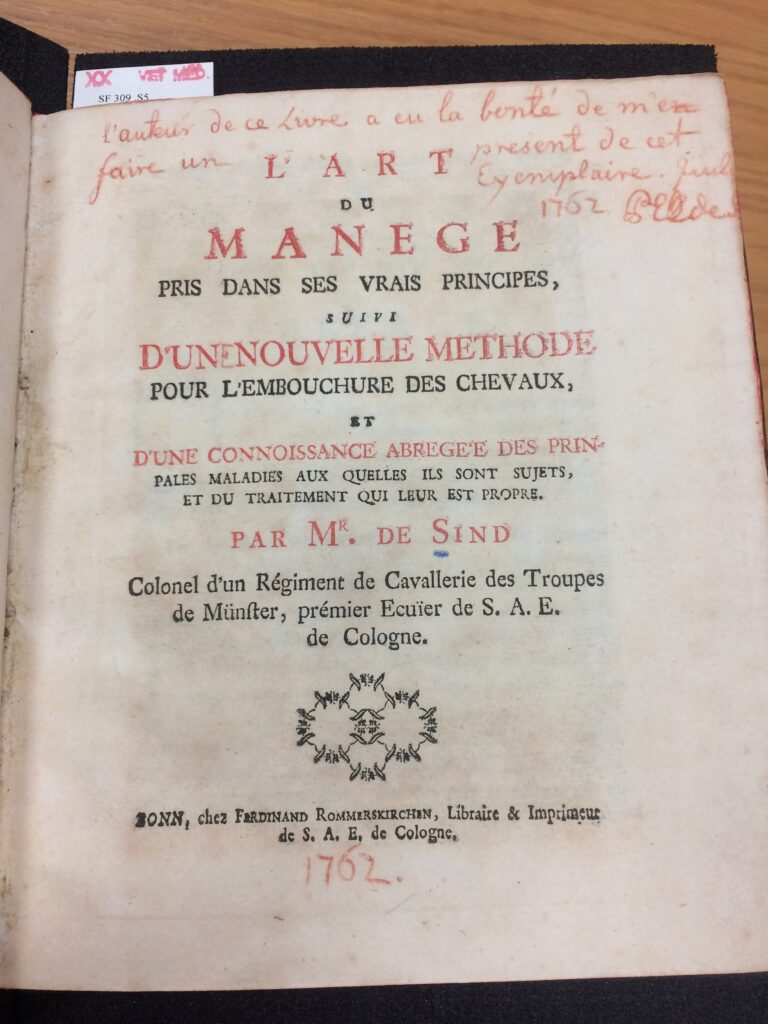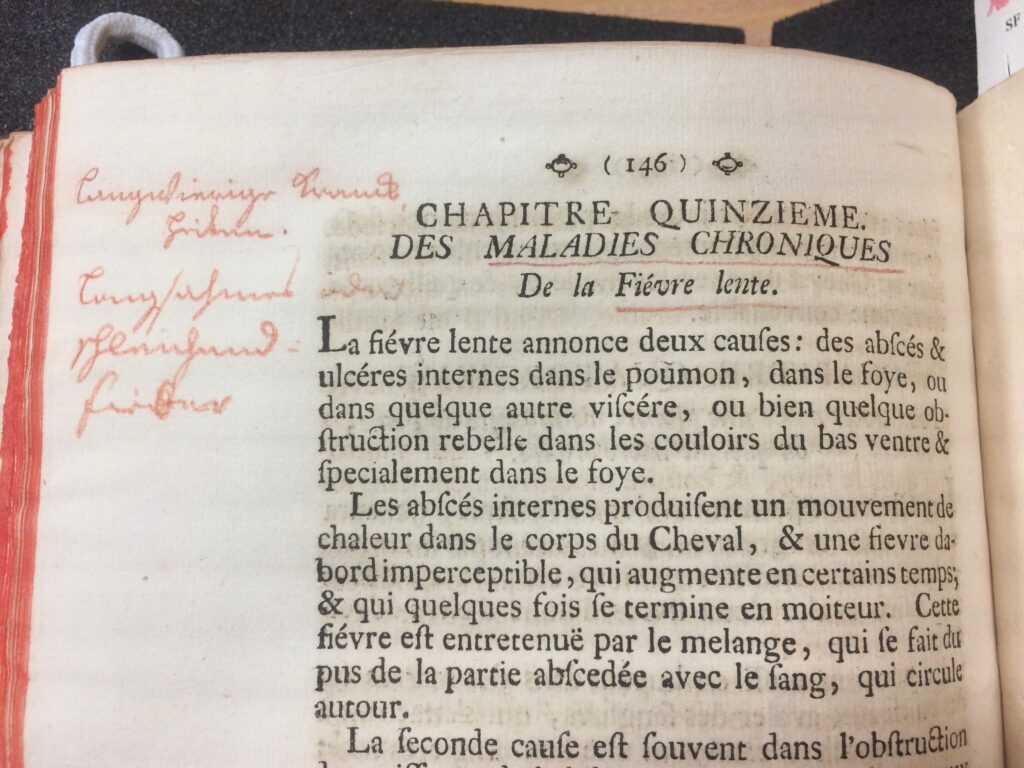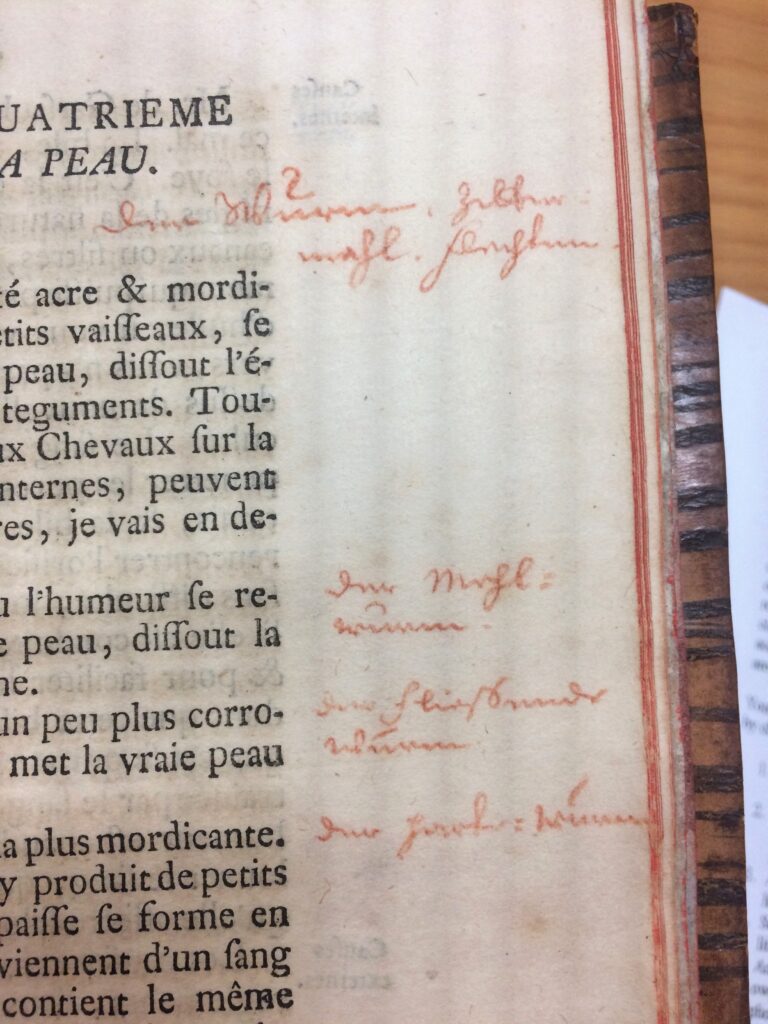pris dans ses vrais principes, suivi d’une nouvelle méthode pour l’embouchure des chevaux et d’une connoissance abrégée des principales maladies
von Sind, Johann Baptist. L’art du manège : pris dans ses vrais principes, suivi d’une nouvelle méthode pour l’embouchure des chevaux et d’une connoissance abrégée des principales maladies, auxquelles ils sont sujets, ainsi que du traitement qui leur est propre. Bonn: Ferdinand Rommerskirchen, 1762. XX SF309 .S5 1772.
Translation of title: “The art of riding: taken in its true principles, followed by a new method for the mouthpieces of horses, and an abridged knowledge of the principal diseases to which they are subject, as well as the treatment proper to them.”
19 cm, 312 pages, 10 unnumbered pages, 5 unnumbered folded sheets: illustrations, portrait; red, yellow, blue, and white marbled board covers, full binding in brown leather; gold gilt illustration on front cover, horizontal fillet embellishment on spine; printed in French.
Physical Description: Binding and the Spine

L’art du manège: pris dans ses vrais principes is bound in full brown leather, featuring a gold engraved coat of arms on the front cover. The coat of arms belongs to the House of Lippe, which was a former reigning house of several small German states. The state of Lippe was founded in 1123, and has existed up until the German Revolution of 1918-1919. The House’s territory was eventually split into various counties, and the Schaumburg-Lippe line of the House of Lippe was founded in 1643.

The coat of arms pictured here is the arms of the principality of Schaumburg-Lippe. Either a crown or three helmets were used in the crest, and the first and fourth quarters of the shield feature a rose, which was the historical rose of Lippe. The second and third quarters of the shield represent the arms of the Schwalenberg family, while the escutcheon is the arms of Schaumburg.

The spine of the book features horizontal gold fillet embellishments, with the author’s last name and the title of the book engraved into the spine as well.




Historical Context
L’art du manège: pris dans ses vrais principes was written in 1772 by Johann Baptist von Sind. Von Sind, estimated to have lived from 1709-1776, was a colonel of a regiment of cavalry troops in Munster, Germany, and was the first squire of the S.A.E. of Cologne. Not much information can be found on the life of von Sind, except for the information presented on the cover page of the book. The provenance information is written on the top of the page in French, reading, “L’auteur de ce livre a eu la bonté de m’en faire un present de cet exemplaire.” This provenance translates to “The author of this book had the goodness of making me a present of this copy.” The note is dated July 1762, and their is a name written underneath, but it is not legible.
L’art du manège : pris dans ses vrais principes, suivi d’une nouvelle méthode pour l’embouchure des chevaux et d’une connoissance abrégée des principales maladies, auxquelles ils sont sujets, ainsi que du traitement qui leur est propre is written in French, and translates to “The art of riding: taken in its true principles, followed by a new method for the mouthpieces of horses, and an abridged knowledge of the principal diseases to which they are subject, as well as the treatment proper to them.” This book offers new insight to the field of equine veterinary medicine, and discusses the various sicknesses and diseases that a horse might contract, as well as how to effectively treat them. L’art du manège also discusses the art of manège, or riding, and how to train one’s horse. Von Sind, having been a colonel in a cavalry regiment, would undoubtedly have had a lot of knowledge on the subject, thus explaining why he may have written the book. His experiences in the cavalry also add to his overall credibility on the subject.
Manège: The Art of Riding
During the 18th century, horsemanship was seen as an art form. Manège, or the art of teaching a horse to dance, required a large expenditure, and while people marveled in its beauty and grace, it also held some political significance. Being able to show that you had control over an animal as large and as powerful as a horse showed your ability for self-control and passion, as well as a certain elegance and refinement. Horsemanship was seen as a direct reflection of your abilities as a leader, so this book not only offers information from a scientific and medical point of view, but also shows the importance of having refined skills such as horsemanship during the 18th century.

Provenance: Bookplates, Stamps, and Marginalia
On the inside pasteboard of the book is a bookplate that reads, “Ex Bibliotheca, J.H. Anderhub, 1937.” This bookplate belonged to Jakob Heinrich Anderhub, who was a German author and mathematician.


On the endpapers and flyleaves of the book, there are several provenance marks. One flyleaf is extensively covered in provenance. In the top left corner, there is a stamp from the Hof-Bibliothek Zurich, with the city of Bückeburg stamped along the bottom of the stamp. In addition, a previous owner of the book wrote down the initials from the front cover—P.E.G.Z.S.L.—and drew up a chart attempting to determine the meaning of the letters. He interpreted the initials as follows:
- P – Philipp, as in Count Philipp Ernest (1659–1753) founder of the Schaumburg-Lippe-Alverdissen line in the House of Lippe
- E – Ernest, as in Count Philipp Ernest (1659–1753) founder of the Schaumburg-Lippe-Alverdissen line in the House of Lippe
- G – graf, a historical title of the German nobility, usually translated as “count”
- Z – zu, German preposition meaning “to”
- S – Schaumburg, a district of Lower Saxony, Germany
- L – Lippe, a historical state in Germany ruled by the House of Lippe during the 12th century
Altogether, the initials read “Philipp Ernest, Count to Schaumburg-Lippe.” There is also some illegible provenance on the bottom of the page written in French.

In addition to the provenance found on the endpapers and the flyleaves, provenance can also be seen in the text block of the book. For example, this page features makrs made by a previous owner of the book. The commentary is written in French, and several of these comments offer advice on how to change some remedies, as well as other names for certain sicknesses and diseases.
These provenance marks show that the previous owner of this book actually took the time to read through every page and leave his own thoughts about the subject alongside von Sind’s original writing.




L’art du manège: pris dans ses vrais principes also features five unnumbered folded sheets, which display various diagrams and figures relating to equine veterinary medicine. The figure on the left represents a bridle, with numbers identifying certain parts of the bridle. However, there are a few provenance marks visible in red ink, where a previous owner renumbered two of the identifications. Throughout the book, this same previous owner left commentary next to certain passages describing particular diseases, drew a line through certain terms and phrases, rewrote the names of certain words, and even made some corrections to recommended treatments.
These forms of provenance have a lot of importance in that they show that this book was actually read carefully and used by someone in the past, and illustrates that they felt the need to make annotations and revise parts of the book that they felt weren’t as specific or correct. Having provenance like this allows us to take a look into the past and see how people interacted with print and publishing.

The rear pasteboard features a stamp with the markings “Foch 20-,” which could have been referencing Marshal Ferdinand Jean Marie Foch, who was a French general and Marshal of France, Great Britain, and Poland, as well as a military theorist and the Supreme Allied Commander during World War I. However, it is not clear if this was his stamp, as the name and the number are both handwritten in ink, and are without any other information.
This exhibit page on L’art du manège : pris dans ses vrais principes, suivi d’une nouvelle méthode pour l’embouchure des chevaux et d’une connoissance abrégée des principales maladies, auxquelles ils sont sujets, ainsi que du traitement qui leur est propre was created by Samantha Fegan, an undergraduate student at Michigan State University.